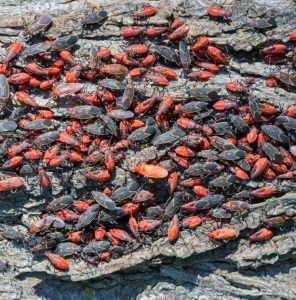BOXELDER BUG CONTROL

Boxelder bugs get their common name from the fact that they are often found on and around boxelder trees. They are most frequently seen congregating in warm spots before migrating indoors to overwinter in insulated cracks and crevices. It is during the change in season that they can become a nuisance to homeowners as they invade in large numbers. Boxelder bugs are black with reddish or orange markings on their back. Their body shape is a somewhat-flattened and elongated oval that is about 1/2 an inch long. They have six legs and two antennae.
Not sure if you have a boxelder problem? Or maybe you want to learn more about how boxelder control works. Check out the following boxelder information to clarify some questions you may have.
Library Shortcuts
- Should I be concerned about boxelder bugs?
- Signs of boxelder bugs infestation
- Tips to prevent boxelder bugs
- Can I get rid of boxelder bugs myself?
Should I be concerned about boxelder bugs?
Boxelder bugs spend their time thriving in nature during the warmer months. They are sap suckers, penetrating plant tissue with their considerable proboscis and using secretions to make it consumable. They almost exclusively feed on the Acer family of maple trees and vines that include the boxelder and its spinning “helicopter” seed pods but have also been known to feed on fruit during dry summers.
When boxelder bugs infest trees they may cause their leaves to yellow and curl or leave spots on stems and new growth. Most trees survive. Damage to grapes, peaches, and other soft fruits is mostly cosmetic, appearing as depressions, sometimes as bruises. While a nuisance, boxelder bugs do relatively little damage to fruit crops, preferring to feed and procreate in its namesake tree.
Once it starts getting cold, they migrate in very large groups to find shelter in hopes of survival. Manmade structures are a good shelter for them; which is why they might enter through cracks and crevices to hide within wall voids for the winter. Boxelder bugs do not sting or transmit diseases and are generally not known to bite, though there are rare reports of defensive biting. While they don’t normally cause structural damage to homes or contaminate food sources (individuals will occasionally show up in dried beans and flour if not stored in tightly-sealed containers), they can be a source of filth, odor, and displeasure due to their sheer numbers.
Signs of boxelder bugs infestation
Boxelders bugs infest most buildings in the fall when they’re looking for a place to survive over the winter. Depending on the ease of access, you may notice up to hundreds of boxelders near your property.
One sign that you can look for in order to identify a boxelder infestation stains. Boxelder bugs produce liquid feces, which may stain the carpet, rugs, and other fabrics. These stains will be small and faded yellow, brown, or grey in color. Boxelders may also stain nearby surfaces when crushed. Stains are most noticeable near areas congregation like window sills and door frames; where you can also check for boxelder bugs swarms.

Tips to prevent boxelder bugs
Boxelder bugs are considered to be overwintering pests, which means they enter your home to escape winters. Gaps around foundations, open vents, and unscreened windows and doors can provide easy access into homes for these pests. The best way to protect your property from an infestation is to prevent them from crawling into your home. Seal entry points to make it more difficult for boxelder bugs to get indoors. You can also consider removing any female boxelder trees from the property or choosing male trees when landscaping and planting may help homeowners avoid future problems.
Can I get rid of boxelder bugs myself?
Trying to control a boxelder bug infestation on your own may result in complications and the worsening of pest activity. If you kill boxelder bugs within the wall voids on your own, the scent of their decaying bodies can attract beetles and increase insect populations within your property. Boxelder bugs also leave a reddish-orange stain from their disposal of feces when they are squished, which can leave marks on your carpet, clothing, and other fabric items. Once they have infested a structure, professional pest control services are the only solution to complete boxelder bug control.

Want a Free Estimate?
Need to Schedule Service?
Have a Questions?
WHAT WILL WE DO?
Our boxelder bug control and bat proofing process typically consists of the following stages:
- Confirm or discard the existence of boxelder bugs in your home through an inspection
- Identify the factors that may be causing and contributing to the infestation
- Offer pest control programs to get the problem under control
- Treat the existing ant population and prevent future infestations
When dealing with overwintering pests, the best time to do treatments is before they come. We suggest that this service begin in the late summer, before they enter.
What our clients are saying
Our Partners and Awards
Service area
New Jersey:
Ocean County
Essex County
Passaic County
Morris County
Hudson County
Bergen County









